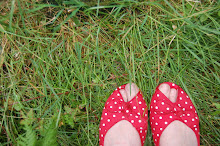Inside was a copy of a brand new book, Handmade Nation, sent to me all the way from Boston by lovely Meighan.
Meighan is the curator/author of the beautiful blog my love for you is a stampede of horses, where right now amongst many other things, you can find pictures from studio visits, images from artists' sketchbooks, meercat brooches, a q&a with artist christian rex van minnen and temporary unicorn tattoos, plus new work from a huge range of emerging artists.
Handmade Nation: The Rise of DIY, Art, Craft and Design investigates today's new wave of craft - a vibrant movement of artists, crafters and designers working with both traditional and nontraditional media to create highly innovative work that's a world away from the traditions of floral embroidery and cross-stitch samplers. Authors Faythe Levine and Cortney Heimerel have travelled 19,000 miles across the US to document this new craft revolution, which fuses traditional handcraft techniques with radical thinking, punk and anti-capitalist culture and the DIY ethos, and frequently crosses the boundary between craft and contemporary art. The book will also be accompanied by a documentary film of the same name due for release in 2009.
This beautifully-presented and inspiring book brings together profiles of 24 artists, designers and makers working with everything from embroidery to rug-hooking, shoe-making and paper-cutting, documenting their work, inspirations and methodologies as well as their work environments and processes. The profiles are accompanied by an interesting and thought-provoking selection of texts which explore the 'handmade' phenomenon in more detail, focussing on some of the related cultural and political issues. Essayists include Andrew Wagner of American Craft Magazine, Callie Janoff of the rather fabulously named Church of Craft, Betsy Greer of Craftivism.com and Susan Beal, author of Super Crafty. Particularly interesting is the essay by Garth Johnson of extremecraft.com, 'Down the Tubes: In Search of Internet Craft,' which highlights the role of the online crafting community, emphasising the importance of the web both as a tool to market and sell products via sites like Etsy.com and as a platform to share ideas, network and collaborate.
With lovely illustrations and lettering by Kate Bingaman-Burt (including a beautiful timeline mapping the rise of craft's new wave that evokes Sara Fannelli's artist timeline at Tate Modern) Handmade Nation is a fascinating snapshot of the contemporary craft phenomenon in the US. The book also provides a valuable context for the movement, touching on the political ideologies at its heart; however, I would have been interested to read more critical writing unpacking some of these ideas in greater depth, investigating the potentially revolutionary agendas of craft's new wave, and positing what the possible futures of the handmade movement might be. Altogether though, there's no doubt that Handmade Nation is a hugely enjoyable read, packed with ideas and inspirations. Here's to the continued rise of DIY, art, craft and design!
For more information about Handmade Nation check out the blog and the official website. There's also a q&a with Faythe Levine on my love for you is a stampede of horses, and an interview with both authors in NYLON here. There are lots of other people jumping on the 'craft' bandwagon at the moment, most recently India Knight in last week's Sunday Times with this article on 'credit crunch chic'.
****
Whilst I was checking out the Princeton Architectural Press website, I also spotted this new book, A Year of Mornings. The book documents another interesting blog-based projects, 3191, which has a good story behind it. On the morning of December 7, 2006, Maria Alexandra Vettese and Stephanie Congdon Barnes each took a digital photo of everyday objects randomly arranged on their kitchen tables and, unbeknownst to one another, uploaded them to Flickr. Noticing a surprising similarity between their images, they decided to continue to document their respective mornings by posting one photo to a shared blog each weekday for a year - 3191, their site is named after the distance in miles between their homes in Portland, Maine, and Portland, Oregon. This new book brings together a range of images from the original Year of Mornings project, but Maria and Stephanie have already embarked on a new collaborative photographic project, entitled A Year of Evenings, which you can see here.








